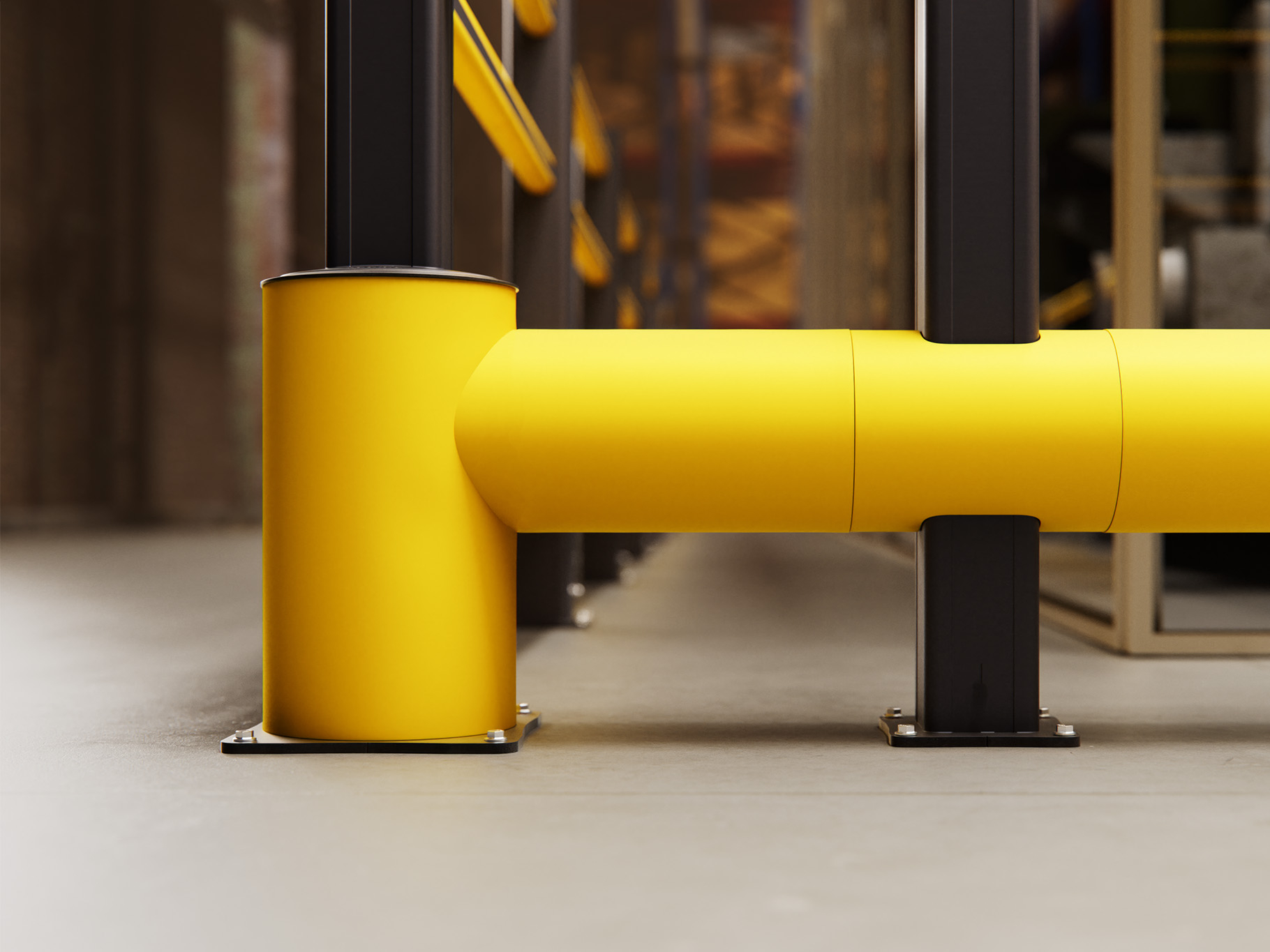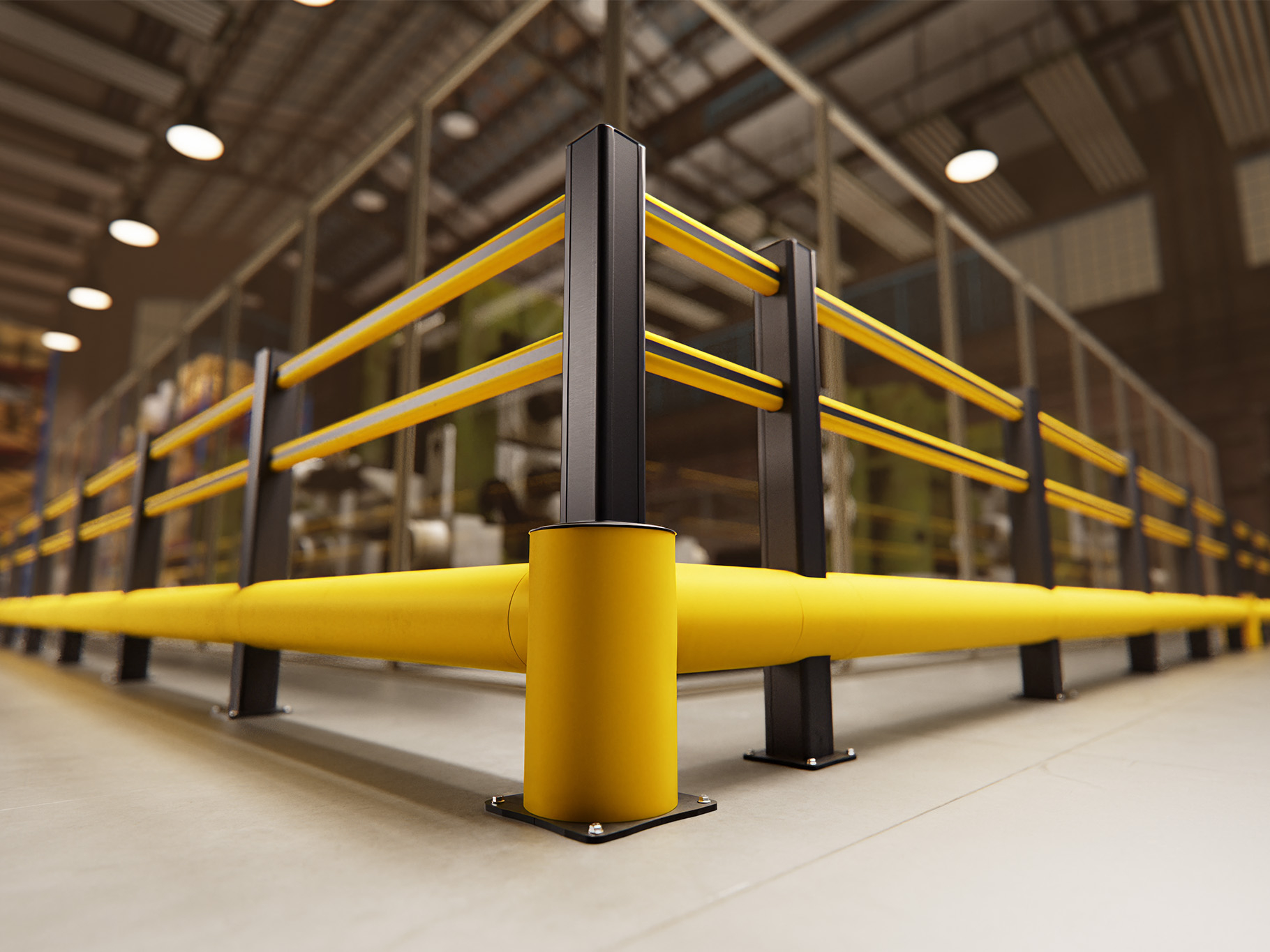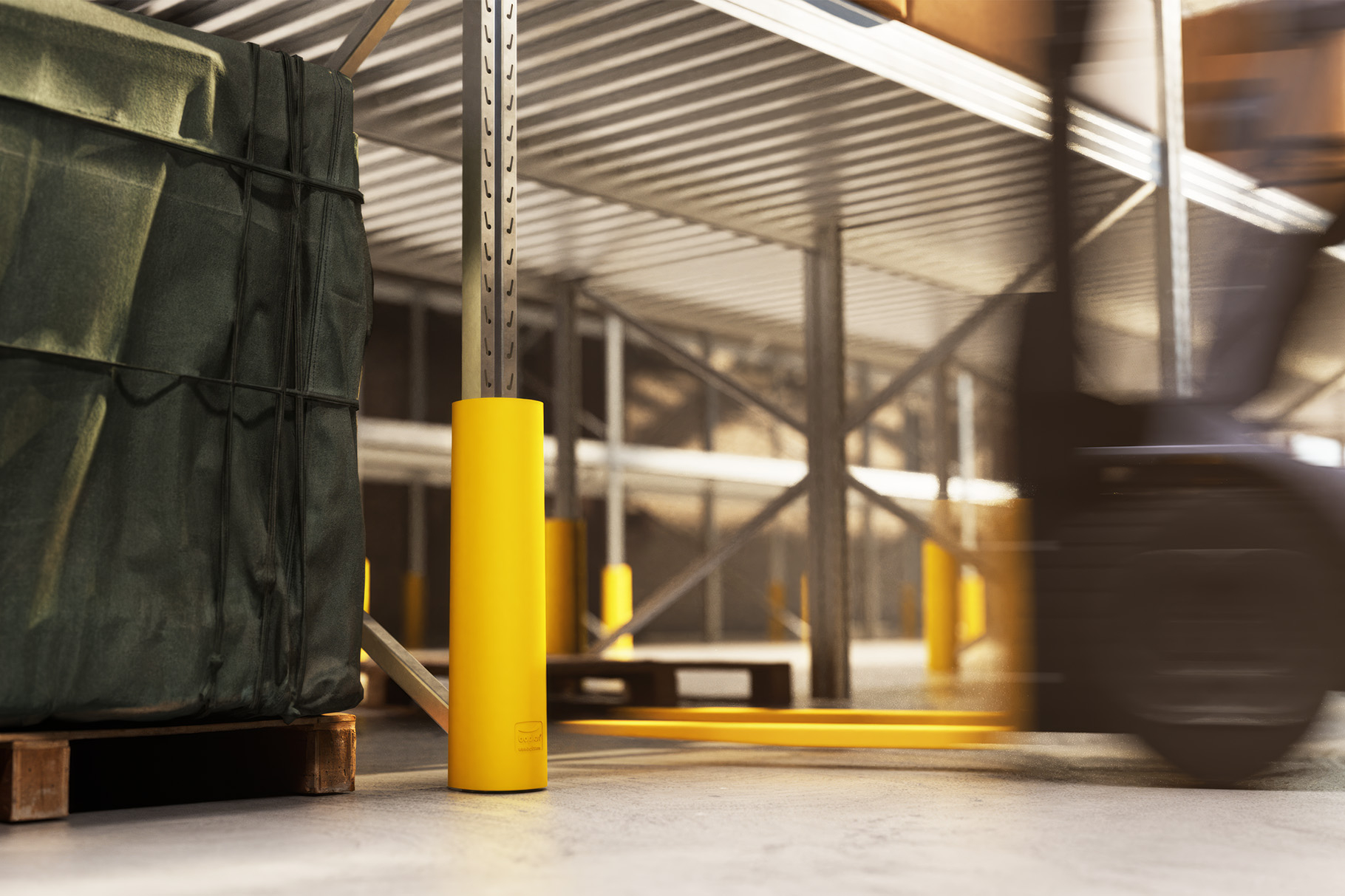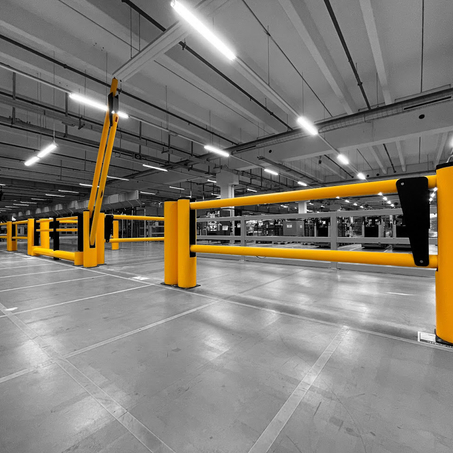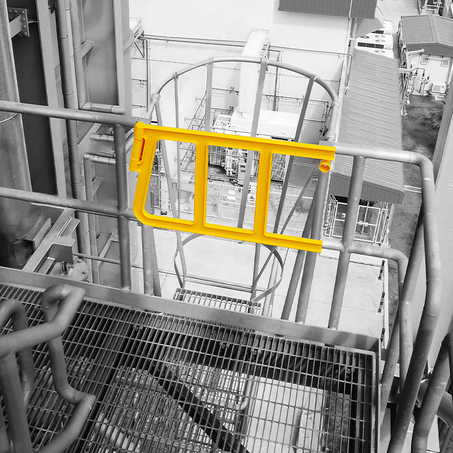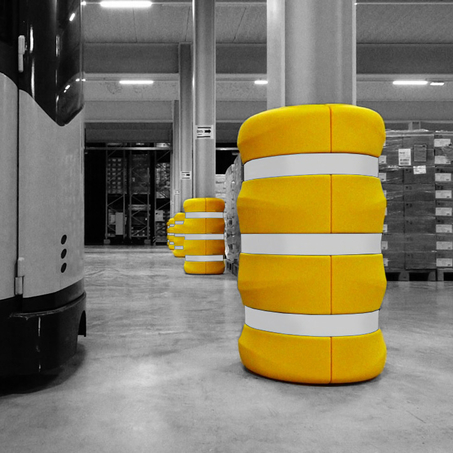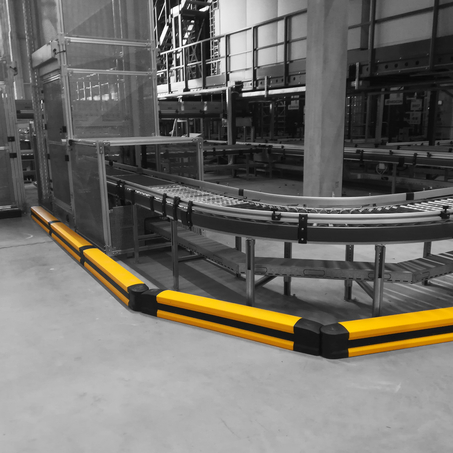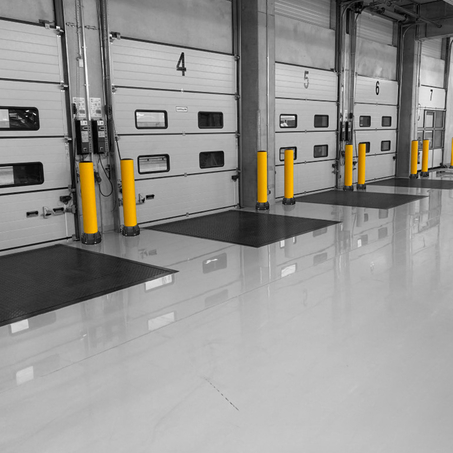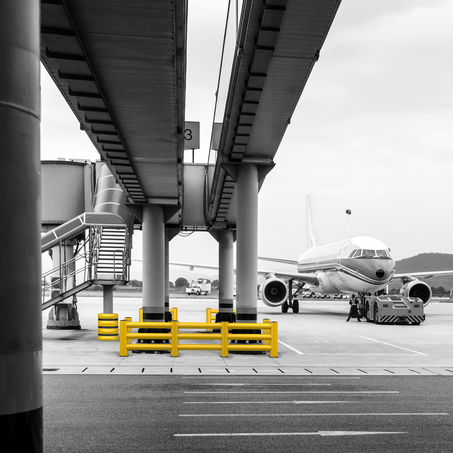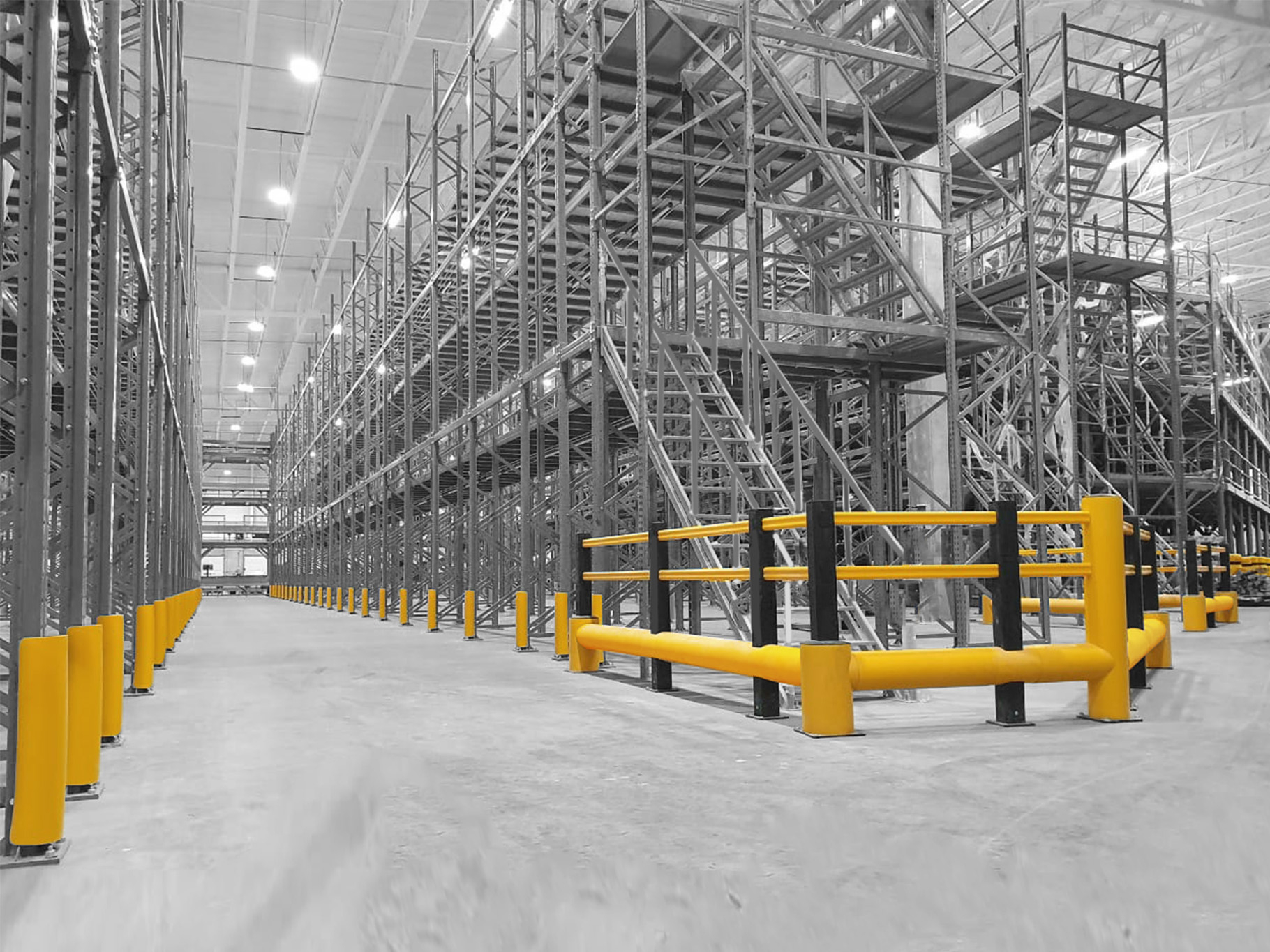Polymer safety barriers
Everything you need to know explained from A to Z.
From distribution, manufacturing, food and beverage to airports … Safety barriers are now essential in many sectors. Not only do people deserve the most adequate and safest protection available on the market; your infrastructure, buildings and vehicles also need protection to keep your business processes as effective and efficient as possible. As a provider of high-performance polymer safety barriers, Boplan plays an important role in achieving structural safety in the workplace. We excel by focusing on sustainable, high-performance safety barriers that are built to last and require little maintenance. You heard that right. Our safety solutions save you a lot of money.

What exactly is Extrilene®?
Safety barriers made of Extrilene® polymer
You may be curious about what goes into our polymer safety barriers. How do we make such robust safety products? For that, we need to go back to basics: polymer.
The name polymer consists of the Greek words poly (many) and meros (part). It is an organic collection of many identical or similar particles that are chemically linked. There are several types of polymers. Synthetic polymers are just one type. This category is more commonly known as plastic. Polymers are used in many applications and there are several synthetic polymers on the market. One example is polyolefins, the family that includes polyethylene and polypropylene. We use a specially developed polyolefin polymer for our safety barriers: Extrilene®.
What are the properties of Extrilene® polymer safety barriers?
Extrilene® is a high-tech flexible polymer. We have developed it exclusively for industrial safety applications. It has extremely high impact resistance and shock absorbing properties. Extrilene® is renowned for its high impact resistance, but also for its excellent recycling properties and applicability in sectors with the highest hygiene requirements. The unique slide-over tube system makes Extrilene® safety barriers the strongest impact resistant collision protection currently on the market.
Lightweight
Polymer is very light. This is a huge advantage. It is easy to transport and install. This significantly reduces the cost of installing barriers, bollards, handrails ... People are often surprised at how light our safety solutions are compared to steel and concrete, but make no mistake. This low weight does not mean their performance is any less. They absorb impact and deflect collisions just as well, if not better. They protect your equipment and facilities and they won't break themselves. In the event of a collision, polymer safety products bend and regain their original shape immediately.
Modular and bold
Our modular safety designs ensure optimal visibility. We mass colour them, so you don't need to paint them. Impacts do not affect their colour. They retain their visibility for life. They will not fade, even after prolonged exposure to direct sunlight.
The products come in a typical yellow colour. Yellow immediately attracts attention and is considered the most effective colour to draw attention to hazards. Employees are more aware of safety barriers in safety yellow, which makes them far more vigilant.
Of course, if you want to use a different colour, you can. Perhaps black is more in keeping with your corporate identity or you may want to use red to mark your fire infrastructure. You also have the option of adding reflectors, integrated LED lights or glow-in-the-dark material.
Cost-saving
Because they regain their original shape, our safety barriers save significant costs. They are built to last and require little or no maintenance. And if you notice any marks, you can usually clean them off with some soap and water or our maintenance spray. You can quickly polish your polymer safety barriers or easily remove dust, deposits or other dirt with Easy Clean. This ozone-friendly product leaves no streaks and contains no abrasives, so you can be sure of the best possible care to maximise your safety barriers' visibility in the workplace.
Customised
You can fully customise the dimensions and orientation of your flexible safety barriers to suit your needs. In the event of a collision or wear and tear, all you need to do is replace the damaged part rather than the whole system. This is a huge cost saving advantage over steel barriers and bollards. In addition, you can easily fit our safety barriers in and around your infrastructure, be it driveways, stacking racks, columns, gates or platforms. You can configure our protective products quickly and easily thanks to their modular installation system.
Polymer safety barriers are resistant to impact, but can also withstand all weather conditions and most chemicals. Environmental factors are not kind to steel. Polymer is stronger and more resistant to the effects of temperature changes, water, oxygen, sunlight and airborne chemicals. Especially in corrosive environments such as the food and petrochemical industries, this is an important argument in favour of polymer safety barriers.
As you can see, Extrilene® polymer safety barriers have many advantages. In fact, there are many more advantages we can list. But perhaps it is more interesting to compare polymer safety solutions with products made of other materials. This will help you to decide which material is best suited to your working environment.
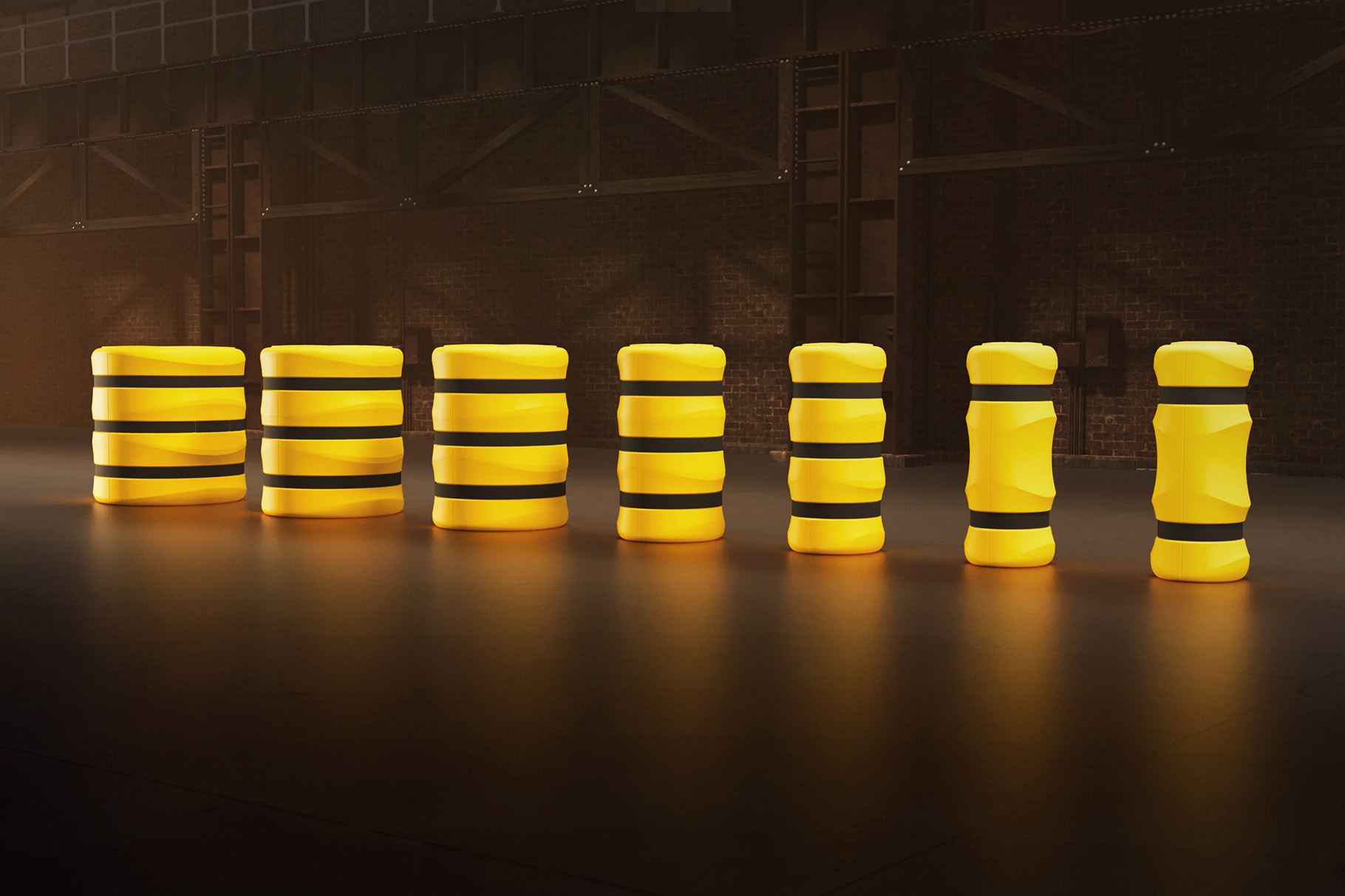
Comparison of polymer, steel and concrete crash protection
In addition to its superior, impact-resistant properties, our polymer (Extrilene®) impact protection offers other advantages against which concrete and steel alternatives inevitably lose out. Below, we compare guard railing in polymer, steel and concrete at several points.
What are we considering?
Concrete
Solid impact protection made of concrete. Often used in public spaces.
Flexible polymer (Extrilene®)
Very strong impact protection made of the sustainable polymer Extrilene®. No iron, concrete or steel.
Steel
Strong impact protection based on stainless steel or metal sheets. Sometimes with a concrete core.
Is the material flexible?
Concrete
No
Flexible polymer (Extrilene®)
Very robust, but also flexible. Regains its original shape after impact.
Steel
No
Is any (after) care required?
Concrete
Yes, needs to be painted to ensure its visibility and durability.
Flexible polymer (Extrilene®)
No. Mass coloured, so no painting required.
Steel
Yes, needs to be painted to ensure its visibility and durability. Regular painting required to prevent corrosion.
Is repair necessary after impact?
Concrete
Yes, single use. Even a small impact causes permanent scratches. Repair or even replacement is required depending on the impact. And then there is also the cost of repairing the vehicle or infrastructure.
Flexible polymer (Extrilene®)
No, regains its original shape after impact. Repairs or replacements are not necessary, taking into account the frequency and level of impact,.
Steel
Yes, single use. Even a small impact causes permanent scratches. Repair or even replacement is required depending on the impact. And then there is also the cost of repairing the vehicle or infrastructure.
Will the floor be damaged after a collision?
Concrete
Yes, upon impact.
Flexible polymer (Extrilene®)
No. A polymer safety product does not damage the floor because it absorbs the force of the impact and distributes it over the volume.
Steel
Yes, if a forklift hits a steel bollard, there is every chance that it pulls the anchors out of the floor. The consequence: damage to the forklift as well as the floor and significant repair costs.
Will the vehicle be damaged?
Concrete
Yes, the forklift will be severely damaged on impact.
Flexible polymer (Extrilene®)
Yes, but the damage to the forklift will be minor because the protective equipment absorbed the impact that would have otherwise gone to the vehicle.
Steel
Yes, the forklift is severely damaged and often the infrastructure behind the protection sustains damage as well.
Is the protection easy to move?
Concrete
No. Concrete elements are heavy and bulky.
Flexible polymer (Extrilene®)
Yes. Polymer protection is lightweight and modular. This makes it easy to disassemble and reassemble elsewhere.
Steel
No. Steel is heavy.
Is the protection easy to replace?
Concrete
No. Must be replaced as a whole.
Flexible polymer (Extrilene®)
Yes. Polymer protection is modular. This makes it easy to disassemble and quickly replace individual parts.
Steel
No. Must be replaced as a whole.
Is the protection recyclable?
Concrete
No.
Flexible polymer (Extrilene®)
Yes.
Steel
No. Technically yes, but using new steel is less damaging to the environment than recycling steel. The paint is also a problem. This means steel is hardly ever recycled in practice.
What does it cost?
Concrete
Concrete is cheap, but not cost-effective. It is expensive to replace the barriers and repair the vehicles after an impact. You also have to factor in maintenance costs, such as regular repainting. This pushes up the TCO.
Flexible polymer (Extrilene®)
Polymer is more expensive to buy, but is cost-effective. After an impact, the protection is still intact and the vehicle shows little or no damage. There are also no maintenance costs. Despite the higher purchase price, the TCO will therefore be lower than for steel or concrete alternatives.
Steel
Steel is cheap, but not cost-effective. It is expensive to replace the barriers and repair the vehicles after an impact. You also have to factor in maintenance costs, such as regular repainting. This pushes up the TCO.
Is the protection resistant to most chemicals?
Concrete
Yes.
Flexible polymer (Extrilene®)
Yes.
Steel
No.
Is the protection suitable for sectors with the highest hygiene requirements?
Concrete
No. Concrete can have cracks and tears in which dirt and bacteria can accumulate.
Flexible polymer (Extrilene®)
Yes.
Steel
No, because there is a risk of rust.
How sustainable are Extrilene® polymer safety barriers?
Companies like to present themselves as green enterprises and show sustainable corporate governance. However, many organisations fail to put these principles into practice, resulting in all talk and little action. Not at Boplan!
What is the Boplan approach?
Boplan is strongly committed to sustainability in the implementation of its high performance and high quality safety solutions. We apply a far-reaching circular philosophy to achieve this.
Did you know that we recycle our own production waste?
Extrilene® safety barriers are made from polyolefin flakes. The main benefit of this polymer is that it is recyclable. Compared to other safety barriers such as steel and concrete, this is a big step forward in the sustainability process. In addition, our safety barriers are modular, easy to reconfigure and have a long lifetime thanks to their flexibility.
How does the recycling process work?
We collect and recycle the polymer waste from the manufacturing of our products at a local recycling plant.
We do this as follows:
- We separate the polyolefin flakes resulting from the cutting, milling and drilling processes by type.
- We clean, dry and re-sort the polyolefin flakes at state-of-the-art recycling lines. This produces a high quality polyolefin with properties similar to virgin polyolefin.
- We reuse these polyolefin flakes in our production process.
What are our recycling figures?
Recycled polymers have many environmental advantages over other processing methods. If we compare polymer recycling with polymer incineration, recycling is clearly the best scenario.
We recycle 89% of our industrial waste. This prevents 344 tonnes of CO2 per year being emitted by the manufacture of new material.
You heard that right: sustainability is an important factor in your choice of safety barriers.
The truth of the matter
Testing and certification of Extrilene® polymer safety barriers
Are you someone who relies on facts? We completely understand. When it comes to safety, we take no chances.
The unique composition of our Extrilene® safety barriers is the result of years of advanced research and development. We frequently test our safety products. We test them ourselves and we have them tested by external, independent parties. This ensures that our safety products are an effective solution to the safety problems in your workplace.
Scientifically developed
As a manufacturer of polymer safety barriers and other protective materials, we are committed to reliability and quality. An extensive series of professional impact tests have scientifically proven the impact performance of Extrilene® safety barriers. We did not perform these tests. The renowned and officially accredited Transpolis Laboratory (France, ISO 17025) did. This French research centre has expertise in testing road safety railings and barriers. We work closely with Dr Emondo Di Pasquale. He has a PhD from Princeton University (USA), is a professor at the University of Valenciennes (France) and specialises in everything to do with collisions and impacts. Boplan can therefore present scientifically substantiated impact results and perform adjusted impact simulations on our safety barriers.
We continue to invest in additional tests to ensure the quality of our safety products. Our products are subjected to many external tests under a wide range of conditions. Based on voluntary testing, we have received the TÜV Nord label for several products.
First, we check our safety barriers in physical tests. We drive a forklift into the safety barrier. We do this at different speeds and impact angles to collect a wide range of scenarios. We then carefully study the consequences of the impacts in the lab. Based on these results, we check how our models stand up in the real world.
These tests show that our safety barriers protect people, infrastructure, objects and machinery far better than traditional barriers. Our safety barriers absorb the impact by distributing the force over the entire equipment. In case of a traditional barrier, two forces collide, resulting in a damaged safety barrier, damaged floor, damaged vehicle and possibly injured employees. Extensive stress and strain testing has shown that the ratio of tensile stress to tensile strain of Extrilene® is lower than that of other polyolefin materials. As a result, we achieve limited deflection upon impact and the tubes and rails bend much less under their own weight.
Extrilene® safety barriers are therefore the best solution for dealing with high risk situations. If you have any questions, you can always count on our expert advice. If you want to consult some scientific reports, you can. Just contact us.
Be under no illusions
You can deliberately destroy any material. Even if you have the safest car made with the best materials. If you drive too fast, the damage on impact is immense. Fortunately, we see plenty of good will and cooperation among employees to maximise safety in the workplace with our Extrilene® safety barriers.
What factors are involved?
The following factors determine how impact resistant your safety barriers have to be:
- The impact angle or collision angle
- The weight
- The speed
The impact angle or collision angle is the angle at which the forklift collides with the safety barriers. This angle greatly affects the force of the impact. The smaller the impact angle, the more force the safety barriers can absorb. In addition to small impact angles, such as 20° and 45°, we also test our products at vertical impact angles (90°). Although this type of collision is rare in the workplace, its impact is the greatest.
The angle of impact alone tells us nothing about its force. The vehicle's weight and speed are also crucial in crash testing. For weight, we take into account the weight of the vehicle and of the load. Speed also plays a role. Forklifts are not allowed to travel faster than 15 km/h according to the safety regulations. It goes without saying that the permitted weight and maximum speed must not be exceeded in order not to jeopardise the proper functioning of the safety barriers.
A tip: Our website has an impact calculator under the product descriptions. You can easily calculate the impact resistance of your safety barriers based on the impact angle, speed and weight.
We also have software that can virtually illustrate all possible conditions in 3D models. This digital simulation allows us to make extensive and thorough simulations of which safety barriers meet your needs. We can do this at short notice and for any application. Interesting, isn't it?
Bring order where there is chaos
If you are planning to improve safety in your workplace to reduce the risk of repair costs or claims, check out our workplace safety overview blog.
